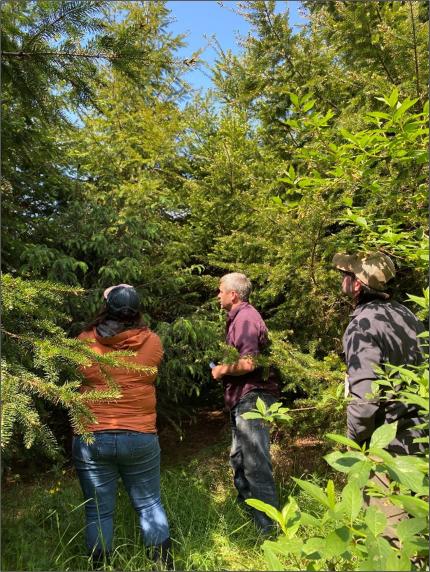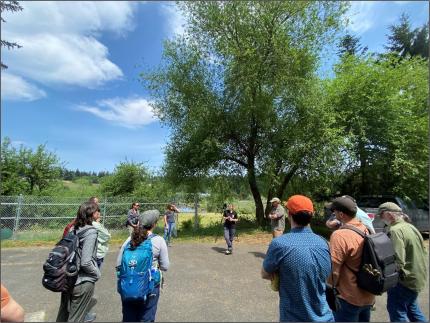Managing Wildlife Populations
Sooty Grouse Population Monitoring: Biologist Tirhi spent some time in May establishing the district’s assigned sooty grouse survey routes. District 11 has four routes to establish and monitor for 2023 (each route having 15-30 listening stations) and three acoustic monitors to deploy. All District 11 routes for 2023 are on Weyerhaeuser property in Game Management Unit (GMU) 667. The routes take a considerable amount of time to establish since each must incorporate an assigned starting location. Forest roads must be investigated for accessibility, permanent listening stations must be established 0.05 miles apart from each other, acoustic monitors must be deployed in secure locations, and logistics of forested locations must be dealt with (snow, clearing downed trees, closed road, etc.). To date, District 11 has established three of the four routes and deployed two of three monitors with plans to conduct actual surveys on the routes the remainder of May and into June.

Sooty Grouse: Biologist Cent established a snow-free sooty grouse survey route and completed one survey, just before the end of the survey period.


Streaked Horned Lark: Biologists Tirhi and Butler completed collecting the first and second of three surveys of state and federally listed streaked horned lark at the Olympia Airport. The airport is one of the four remaining breeding locations for larks in the South Puget Sound. Tirhi reported 16 observations of individual birds (Butler's totals are not available at this time) which appear to be stable compared to the last count conducted in 2020. Butler and Tirhi added additional survey area for the first time this year such that all grasslands at the Olympia Airport were now included in the survey. These extended areas have traditionally not contained breeding larks and so were left out of previous surveys for expediency of meeting survey protocol timelines. Surveys should begin within half hour of sunrise and end by 11:00 a.m. or earlier on 80-degree days. The extended surveys added significant time to the survey which took the team almost nine hours to complete! This also took the survey outside of the protocol ending timelines; this contingency was approved by our Science Lead Pearson when necessary. Tirhi concluded that a third observer will be necessary to complete future surveys closer to established protocol.
Streaked Horned Lark: Biologists Cent and Novack completed initial surveys for streaked horned lark at various sites. Larks were plentiful at Midway Beach.
Snowy Plover: Biologists Cent and Novack with assistance from other WDFW and non-WDFW staff members completed surveys for western snowy plovers on Washington beaches in conjunction with the range wide surveys conducted in Oregon and California. Final numbers are pending but appeared to be low at Midway Beach and Leadbetter Point.
Band-Tailed Pigeon: Biologists Novack and Cent went to District 16 to establish a pair of trapping sites for band-tailed pigeons. The two landowners kept the traps open and baited for a number of days until Biologists Novack, McMillan, Hamer and Section Manager Spragens were able to conduct captures. Nine birds were caught at Clallam Bay and the team attached three transmitters. An additional three transmitters will be attached at a later date.
Conserving Natural Landscapes
Union River: Noxious Weed Coordinator Heimer and Wildlife Area Manager Laushman toured the Theler Wetlands in Belfair with weed specialists from the Mason County Noxious Weed Board to plan for future invasive species treatment in the area.

South Puget Sound Volunteer Event: The Clover Park Rotary Club coordinated their biannual community workday at the South Puget Sound Unit. Volunteers helped weed and mulch the native garden, add boundary blocks, and pulled Scotch broom.

Discovery Bay Visit: Forest Specialist Tveten and Wildlife Area Manager Laushman met with staff members from the North Olympic Salmon Coalition (NOSC) to discuss forest health conditions in the Discovery Bay Unit. NOSC has helped to plant native riparian habitat on the unit along Snow and Salmon creeks for the last two decades, and now are considering how best to treat the growing stands. Tveten advised the group on thinning methods and tree health.

Scotch Broom Bio-Control Release: In early May, the Olympic Wildlife Area staff members employed a new approach in controlling Scotch broom, the release of 600 Bruchidius villosus, also known as the Scotch broom bruchid. The bruchid, a type of bean weevil, was first approved by USDA and released in the Pacific Northwest in 1998 to limit seed production of Scotch broom. The female bruchid will typically lay about ten eggs on the seed pod of the plant. The larva then hatches from the egg at the point it is attached to the pod and burrows into the pod, where it develops and feeds on the seeds. Once a population is established, usually taking about three years, seed pod attack rates are expected to be highly variable (10-90%) as is seed destruction (20-80%). Like all bio-controls this insect alone will not eradicate Scotch broom, but in this case, it will hopefully become a contributing factor in preventing it from spreading.


Lands 20/20 Proposals: Biologist Novack presented a number of proposals to Lands Division and other regional staff members for potential inclusion in the upcoming Lands 20/20 cycle.
Conducting Business Operations and Policy
Onboarding: Biologist Tirhi completed required checklist for onboarding Seasonal Technician Sharpe, including having her complete the required training and policy reviews. District 11 is excited to have Sharpe onboard to assist with western pond turtle monitoring, Oregon spotted frog water hydrology monitoring, and other ad hoc district tasks.
Equipment Inventory: Biologists Novack and Cent completed their equipment inventory for the year.
Other
South Puget Sound: The Ecosystem Services Division from the Habitat Program conducted a field visit and meeting at the South Puget Sound Unit in Lakewood. Wildlife Area Manager Laushman and Biologist Butler presented their work in the area to the group and walked the unit together.
